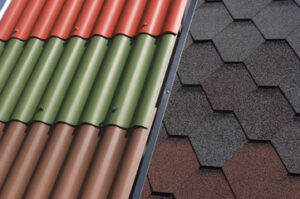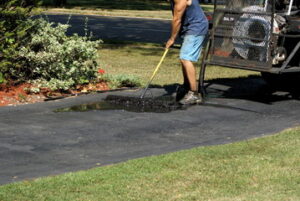Taking care of minor damage can make your garage door last longer. Cosmetic damage like a few small cracks and dents can be repaired fairly easily, as can issues with paint and hardware.

However, more serious damage can cause erratic movement of the door or even pose a security threat. Professional maintenance and repairs are the best way to prevent this from occurring. Contact Garage Door Repair Buckeye AZ now!
The springs in your garage door counterbalance the weight of the door, so they’re under a lot of tension. If the springs break, the door will become unbalanced and could fall down unexpectedly. This is why it’s important to keep an eye out for signs that your springs are wearing out and need to be replaced.
A professional technician can replace your broken springs with care and expertise. They’ll disconnect the opener and manually handle the door, ensuring it’s securely braced before they remove the old springs and install the new ones. Depending on your door type, the replacement process could take 30 minutes to an hour or more. Once the technician has removed the old springs and installed the new ones, they’ll reconnect the opener and conduct a balance test to ensure the door is working properly.
When choosing new springs, look for durable materials with protective coatings that will stand up to the elements. You’ll also want to choose the correct size of springs for your door, so make sure you have the right measurements before starting the installation process. Once you have the basic dimensions of your springs, you can use our Spring Finder tool to find a replacement with similar design characteristics. Simply input the spring’s outer diameter, inner diameter, free length, and force to get started.
To extend the life of your new springs, lubricate them regularly with a silicone-based lubricant. Apply a light coat to each coil and then open and close the door several times to spread the lubricant evenly across the entire surface area. It’s best to do this every 3-6 months, but it’s not a substitute for routine maintenance from a professional. Remember, a garage door is under high stress, so trying to repair, adjust or replace the springs without proper training and tools can be extremely dangerous!
Track Adjustment
Tracks serve as railroad lines for your door, guiding the rollers up and down, making sure the door moves predictably each time. But when they are misaligned, the whole system can become off-kilter and even dangerous. This type of problem typically announces itself with loud, scraping sounds during operation and can also result in visible gaps between the rollers and the track. If the problem is significant, the door may even jump off of its tracks, a dangerous situation that requires immediate attention.
To make a repair like this, first loosen the screws that hold the track brackets to the jamb with a wrench or screwdriver. Loosening the screws allows you to move the bracket in or out to get the track into proper alignment. Once you have the track in place, tighten the bolts to secure it.
Next, identify the cause of the misalignment. This step is particularly important if the issue is with an overhead track, since you cannot work on it with the door raised. Look for signs of a bent track section, including a gap that extends to the sides of the garage door. Minor bending can be straightened with leverage from vise-grip pliers, while significant damage will require professional attention.
Once the damage has been assessed, disconnect the power source to your garage door opener and secure it with clamps or vice grips to prevent it from moving unexpectedly during the repairs. Before starting to work, it is a good idea to put down some old newspaper or other protective covering to prevent any accidental spills or debris from damaging the surface.
Raise the door to the vertical position and check for alignment. You want the rollers to show about a 1/2″ to 3/4″ margin between them and the tracks. If the margin is too small, loosen the track brackets and use a hammer to tap the track into place. Be careful not to apply too much pressure, since a track that is too bent can break under the weight of your garage door. Once the track is in place, tighten the brackets to secure it.
Cable Replacement
Garage door cables support the weight of your garage door and work with springs to lift and lower the door. They can be damaged or worn down by regular use, and if they snap, it can cause significant damage and pose a serious safety risk. Taking care of cable issues with routine maintenance like cleaning tracks, lubricating moving parts, tightening loose hardware, and inspecting the cables regularly can help extend their life. When the cables do wear out, a professional can assess the condition and recommend repair or replacement.
One clear sign that it’s time to replace your garage door cables is a loud “snap” sound when the door opens or closes. In some cases, the cables may simply need to be rewound or realigned. A professional can also advise you on the best type of cable for your specific door.
Besides the obvious visual signs of a cable problem, your door may make other noises as it moves or is operating. Often, this is caused by misaligned or rough tracks that put extra stress on the cables. In these cases, an experienced technician can help by adjusting the track or rollers to fix the issue and reduce stress on the cables.
The other common problem is a lack of balance, which can also cause the door to slam shut or become difficult to open and close. This can be a sign of faulty pulley bearings, which can make squeaking or grinding noises and give off a slight burning smell. Replacing the pulley bearings can help extend the lifespan of the cables.
Replacing a garage door cable is a complex job that requires special tools and knowledge of the system’s design. It’s not something a do-it-yourselfer should try, as the process involves working with high-tension springs and wires. Hiring a professional ensures the job is done properly and safely, which helps avoid future breaks and saves you money in the long run.
Bottom Seal Replacement
The bottom seal, also known as the weather seal or the door sweep, prevents water, debris, cold drafts, and pests from entering the garage. A well-installed seal provides a vital first line of defense against these unwelcome guests, which can cause damage, increase utility costs, and pose health risks for residents. A high-quality bottom seal also helps maintain indoor air quality and reduce energy consumption.
To ensure proper functioning, the bottom seal should be inspected regularly for signs of wear or tear. If the seal is cracked, torn, or excessively worn, it should be replaced as soon as possible to protect the garage from external elements and reduce energy costs. In addition to replacing the seal, homeowners can also perform simple maintenance tasks like lubricating the garage door rollers and tracks to prevent erratic movements and prolong the life of the new seal.
Once the new seal is installed, homeowners should test its functionality by closing and opening the garage door a few times to check for any resistance or gaps. Additionally, they can test the automatic reversing mechanism by placing an object in the path of the door as it closes; the door should automatically reverse upon sensing the obstruction. Once the seal is properly installed, homeowners should apply a silicone-based lubricant to keep it flexible and effective for the long term.
If you’re planning to install a new garage door seal, make sure you have the following supplies on hand:
A tape measure (for measuring the width of the existing seal accurately). Seals come in a variety of shapes and sizes, so it’s important to determine which type is currently in place. For instance, some seals slide into retainers, while others are attached with adhesive strips or screws. It’s also essential to identify the type of channel the seal will be placed in—some are designed for use with specific door types and materials.
Once you have the right size seal in place, carefully cut off any excess length with a utility knife or razor blade. It’s also a good idea to wipe down the channels on both sides of the garage door with a damp cloth or sponge to remove any dirt, dust, or residue that could compromise the installation process and the integrity of the new seal.



